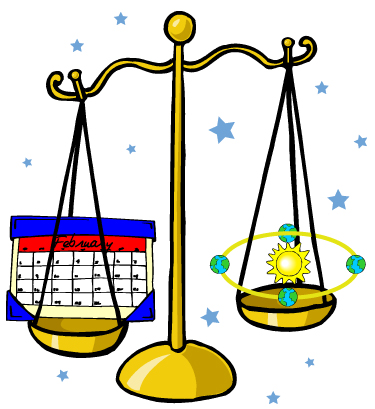With all the high-tech, Internet-based calendars making it possible for us to get through our daily lives, we often forget that none of it could function without an understanding of natural history. The earth and the sun in particular, and, even more particularly, leap years.
By Bill Lawyer
With all the high-tech, Internet-based calendars making it possible for us to get through our daily lives, we often forget that none of it could function without an understanding of natural history. The earth and the sun in particular, and, even more particularly, leap years.
I can’t remember when I first learned about leap years, but it was around the same time I learned that somewhat imperfectly metered rhyme, which goes:
Thirty days hath September,
April, June, and November;
All the rest have thirty-one,
Save February, with twenty-eight
days clear,
And twenty-nine each leap year.
 Long before people realized the earth revolves around the sun – and not vice-versa – they knew that the sun’s position in the sky varied on a roughly 365-day cycle. Keeping track of the sun is one of the reasons that ancient cultures built structures like Stonehenge.
Long before people realized the earth revolves around the sun – and not vice-versa – they knew that the sun’s position in the sky varied on a roughly 365-day cycle. Keeping track of the sun is one of the reasons that ancient cultures built structures like Stonehenge.
But by the time of the ancient Egyptian culture, people had figured out that dividing the year into 365 days just doesn’t work out. That’s because the exact cycle of the sun/earth is actually six hours, 11 minutes, and 14 seconds less than 365 days.
The Egyptians, and later the Romans, came up with the solution of adding an extra day to the calendar every four years. The Romans decided to work it out using the month of February, keeping it short. (Of course, for all who live in places where there are plenty of dark, cold days, February can’t be short enough!)
For those of us of a certain age whose birthdays are after February 29, leap year means that our getting another year older is put off for an extra day. And those who are born on the 29th, such as Frederick in Gilbert and Sullivan’s “Pirates of Penzance”, will not reach their 21st birthday until they are 84!
But, as Borgna Brunner put it in her Infoplease website article, “Leap Year 101”, “Even if you add a leap day every four years, the calendar would still overshoot the solar year by a little bit — 11 minutes and 14 seconds per year. These minutes and seconds really start to add up: after 128 years, the calendar would gain an entire extra day.”
So, what’s the solution to this problem? Fortunately, it’s a fairly simple one, even for those of us who are mathematically challenged. The people who developed what is known as the Gregorian calendar, back in the late 16th century, came up with it: every century year that can be divided evenly by 400, will be a leap year.
While this system isn’t perfect – the calendar year is about 30 seconds off – we won’t have to make an adjustment for another 3,300 years. I think that takes it off my plate of things to worry about.
Meanwhile, the birds, butterflies, bees, and the rest of the natural world have managed to get along quite nicely without making up calendars and then filling them in with play dates, conferences, and Super Bowls.
Many creatures and plants have been observed by naturalists to have an “internal calendar” that regulates their behavior. For some it involves responding to the length of the days, or the rise and fall of the temperatures. With our warm fall and winter (the average temperature in December was 8 degrees above normal), I noticed several forsythia shrubs flowering around Rye. For them, the addition of one extra day every four years doesn’t really matter.















